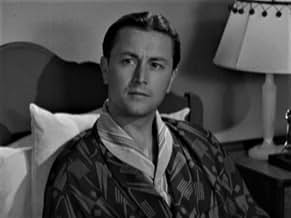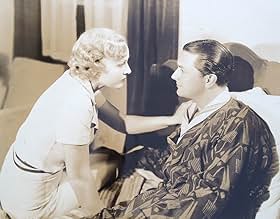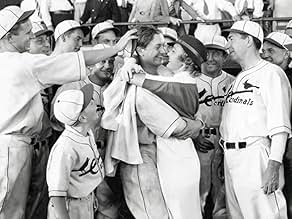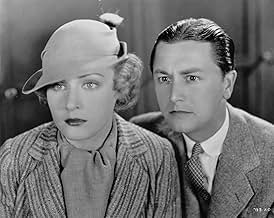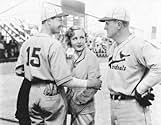Ajouter une intrigue dans votre langueA losing baseball team starts losing its players to strange killings, and the team's new pitcher takes a swing at finding the killer.A losing baseball team starts losing its players to strange killings, and the team's new pitcher takes a swing at finding the killer.A losing baseball team starts losing its players to strange killings, and the team's new pitcher takes a swing at finding the killer.
- Réalisation
- Scénario
- Casting principal
Joe Sawyer
- 'Dunk' Spencer
- (as Joe Sauers)
Ernie Alexander
- Dick
- (non crédité)
Brooks Benedict
- Game Radio Announcer
- (non crédité)
Bruce Bennett
- Man on Ticket Line
- (non crédité)
Red Berger
- Baseball player
- (non crédité)
Avis à la une
This is an OK film. If you have 70 minutes to kill, this isn't something you'll regret killing them with, but it won't stick with you years later.
The film centers on a series of bizarre murders of top players on a losing St. Louis baseball team. The owner (David Landau as Pop Clark) has mortgaged everything to recruit pitcher Larry (Robert Young). If the season is bad he loses everything to his creditors. There is "the obvious suspect" in one particular gangster and gambler who seems unhappy about the improving stats of the St. Louis team with Larry on the mound, but that's the point. He seems just a little too obvious.
The first criminal thing to happen is that a tire on the car that Larry is riding in being shot out. The car rolls over and Larry could have been killed, but he's not, and that doesn't seem to have been the intention. There are clearly at least two people involved in this first shooting, but they are anonymous. All of the crimes that follow are actually murders or attempted murders and very un-gangland like - poison being substituted for mustard, a player being strangled with the murderer's bare hands, etc. So, Larry, now recovered, is the team's only hope of winning the pennant. Will he play or will he stay safe? Watch and find out.
This film is noteworthy for several reasons. For one, it really is a mystery as to who is doing all of this, as the gangland gambler is the only obvious suspect, and keeps the film interesting. It also gives David Landau, who played so many villains, a chance to play a good but crusty fellow for a change. Paul Kelly as a newspaperman who is investigating the murders as much as he is covering the team by the time the film is over is always a welcome sight with his likable wise-guy persona. The police are certainly messing up this investigation, so it is good to have Kelly on the case.
And now the not so good stuff. The romance between Pop's daughter (Madge Evans) and Larry falls flat as a pancake. There is zero chemistry there - Gable and Harlow these two are not. They were both good supporting players, but until Robert Young took on his TV roles when he was older, I just never thought much of him as a leading man, particularly over at MGM. Then there is Ted Healy. He is just not funny. When he cut the Three Stooges loose it was the best thing that could have happened to them.
I'd still recommend it for the murder mystery.
The film centers on a series of bizarre murders of top players on a losing St. Louis baseball team. The owner (David Landau as Pop Clark) has mortgaged everything to recruit pitcher Larry (Robert Young). If the season is bad he loses everything to his creditors. There is "the obvious suspect" in one particular gangster and gambler who seems unhappy about the improving stats of the St. Louis team with Larry on the mound, but that's the point. He seems just a little too obvious.
The first criminal thing to happen is that a tire on the car that Larry is riding in being shot out. The car rolls over and Larry could have been killed, but he's not, and that doesn't seem to have been the intention. There are clearly at least two people involved in this first shooting, but they are anonymous. All of the crimes that follow are actually murders or attempted murders and very un-gangland like - poison being substituted for mustard, a player being strangled with the murderer's bare hands, etc. So, Larry, now recovered, is the team's only hope of winning the pennant. Will he play or will he stay safe? Watch and find out.
This film is noteworthy for several reasons. For one, it really is a mystery as to who is doing all of this, as the gangland gambler is the only obvious suspect, and keeps the film interesting. It also gives David Landau, who played so many villains, a chance to play a good but crusty fellow for a change. Paul Kelly as a newspaperman who is investigating the murders as much as he is covering the team by the time the film is over is always a welcome sight with his likable wise-guy persona. The police are certainly messing up this investigation, so it is good to have Kelly on the case.
And now the not so good stuff. The romance between Pop's daughter (Madge Evans) and Larry falls flat as a pancake. There is zero chemistry there - Gable and Harlow these two are not. They were both good supporting players, but until Robert Young took on his TV roles when he was older, I just never thought much of him as a leading man, particularly over at MGM. Then there is Ted Healy. He is just not funny. When he cut the Three Stooges loose it was the best thing that could have happened to them.
I'd still recommend it for the murder mystery.
The only reason to see this picture is for its historical value. You can trace the beginnings of some Hollywood careers as the film contains some famous movie names. It is also an interesting commentary on how sophisticated Major League baseball has become in the ensuing years; major league rules, regulations and business structure - how innocent and unstructured life and baseball were years ago.
It's a nice vehicle for Robert Young and the lovely Madge Evans but the story is trite and predictable. There are numerous plot holes to navigate but if you can just overlook them you can make your way through a harmless 69 minutes.
It's a nice vehicle for Robert Young and the lovely Madge Evans but the story is trite and predictable. There are numerous plot holes to navigate but if you can just overlook them you can make your way through a harmless 69 minutes.
Someone's trying to keep St. Louis's baseball team from winning the pennant by killing off the players!
No wonder this antique rarely if ever showed up on a Late Show. As a whodunit, the movie generates little suspense as a multitude of characters drift in and out of the meandering scenes. In fact, the plot with a shadowy character shooting players during the game is pretty contrived.
Then too, the occasional poorly done process shots, usually backgrounding Larry (Young), keep reminding you that this is after all only a movie. The badinage between umpire O'Toole (I think) and player Hogan about the former's eyesight gets tiresome even if it does turn poignant in the end. Then too, I don't know where director Sedgwick was during the confession scene, but as others point out, it has to be seen to be believed.
On the other hand, Young does a reasonable job emulating a big league pitcher and is his usual engaging self, while Evans (Frances) and Kelly (reporter Jimmie) outshine the third-rate material. As an old Cardinal fan from the days of Musial and Schoendienst, I did enjoy seeing shots of old Sportsman's Park packed to the rafters. Nonetheless, the movie just doesn't cut it, and not because of its creaky age.
No wonder this antique rarely if ever showed up on a Late Show. As a whodunit, the movie generates little suspense as a multitude of characters drift in and out of the meandering scenes. In fact, the plot with a shadowy character shooting players during the game is pretty contrived.
Then too, the occasional poorly done process shots, usually backgrounding Larry (Young), keep reminding you that this is after all only a movie. The badinage between umpire O'Toole (I think) and player Hogan about the former's eyesight gets tiresome even if it does turn poignant in the end. Then too, I don't know where director Sedgwick was during the confession scene, but as others point out, it has to be seen to be believed.
On the other hand, Young does a reasonable job emulating a big league pitcher and is his usual engaging self, while Evans (Frances) and Kelly (reporter Jimmie) outshine the third-rate material. As an old Cardinal fan from the days of Musial and Schoendienst, I did enjoy seeing shots of old Sportsman's Park packed to the rafters. Nonetheless, the movie just doesn't cut it, and not because of its creaky age.
There's an inherent danger in any movie director taking on a sports movie, and it's this: Very few directors know anything at all about the sport they're depicting, while the viewers they're courting know EVERYTHING about it.
That being a given, I am very impressed that this movie --- remember, it was made only a few years after talkies appeared --- has actual locations shots at L. A.'s Wrigley Field, Cincinnati's Crosley Field, and many actual MLB scenes at St. Louis's Sportsmans Park (Busch Stadium #1). That baseball shrine in north St. Louis was my Holy Grail as a boy.
Like a cop watching a crime movie and slapping his forehead going "That would never happen in real life", any true baseball fan will have his face-plant moments watching this --- like very early on when the put-upon umpire keeps pronouncing his title as "empire" --- but give it a chance. It's surprisingly authentic, and topical, with today's sports gambling clearly out of control, and MLB hanging its integrity from a Sword of Damocles human hair, making this 1934 movie a prescient parable of where pro sports' Faustian deal with gambling is certain to lead.
There's one gaffe so huge you could steer Elon Musk's ego through it: What should be the movie's most suspenseful scene, the denouement, instead is laugh-out-loud funny, in part due to a very poor choice of sound effect.
It was made not to be an Oscar nominee or Ebert's Great Movies entry, but just to be the final in a triplex at the corner movie theater, keeping summertime moviegoers buying popcorn and soda back when baseball was the national sport.
Set your expectations accordingly and you might enjoy it, especially when a baserunner is gunned down trying to score.
That being a given, I am very impressed that this movie --- remember, it was made only a few years after talkies appeared --- has actual locations shots at L. A.'s Wrigley Field, Cincinnati's Crosley Field, and many actual MLB scenes at St. Louis's Sportsmans Park (Busch Stadium #1). That baseball shrine in north St. Louis was my Holy Grail as a boy.
Like a cop watching a crime movie and slapping his forehead going "That would never happen in real life", any true baseball fan will have his face-plant moments watching this --- like very early on when the put-upon umpire keeps pronouncing his title as "empire" --- but give it a chance. It's surprisingly authentic, and topical, with today's sports gambling clearly out of control, and MLB hanging its integrity from a Sword of Damocles human hair, making this 1934 movie a prescient parable of where pro sports' Faustian deal with gambling is certain to lead.
There's one gaffe so huge you could steer Elon Musk's ego through it: What should be the movie's most suspenseful scene, the denouement, instead is laugh-out-loud funny, in part due to a very poor choice of sound effect.
It was made not to be an Oscar nominee or Ebert's Great Movies entry, but just to be the final in a triplex at the corner movie theater, keeping summertime moviegoers buying popcorn and soda back when baseball was the national sport.
Set your expectations accordingly and you might enjoy it, especially when a baserunner is gunned down trying to score.
As a mystery, Death on the Diamond contains all of the genre trappings to keep you guessing until the end. Nearly half of the cast is set up as "red herrings" and if the unmasking of the real killer is something of a disappointment, it really doesn't matter. The real reason to watch this curio is its cast. Robert Young, one of Hollywood's most underrated leading men, is fine as the cocky star pitcher; his opening scene with Madge Bellamy, who is equally good, crackles with snappy dialogue. Nat Pendleton, as a beefy slugger, and Ted Healy, as a touchy umpire, make a fine comic duo. [Healy's reaction to his pal's untimely demise is surprisingly touching.] And look fast for Walter Brennan as a hot dog vendor and Ward Bond as a cop. The film is rife with an atmosphere of golden age baseball, which helps elevate an average mystery into something imminently watchable.
Le saviez-vous
- AnecdotesFred Graham was working in the MGM sound department and also playing baseball semi-professionally in his off-time. He was hired to tutor star Robert Young in baseball techniques. He also was hired to double Nat Pendleton in his scenes as a catcher, thereby beginning a nearly 40-year career as an actor and stuntman.
- GaffesWhen the game resumes, after the bad guy is caught, the camera pans across the scoreboard to show that the game is tied, 2-2. The radio announcer then states, "Cincinnati hasn't scored since Kelly threw that ball into the dugout and let the tying run come in." Cincinnati was the visiting team and the last run it scored, in the top of the second inning, would have made the score 2-1 (Cincinnati leading). It would not have been a tying run.
- Bandes originalesTake Me Out to the Ball Game
(1908) (uncredited)
Music by Albert von Tilzer
Lyrics by Jack Norworth
Played during the opening and closing credits
Played as background music often
Meilleurs choix
Connectez-vous pour évaluer et suivre la liste de favoris afin de recevoir des recommandations personnalisées
Détails
- Date de sortie
- Pays d’origine
- Langue
- Aussi connu sous le nom de
- King of the Diamond
- Lieux de tournage
- Saint-Louis, Missouri, États-Unis(baseball diamond and grandstand backgrounds)
- Société de production
- Voir plus de crédits d'entreprise sur IMDbPro
- Durée1 heure 11 minutes
- Couleur
- Rapport de forme
- 1.37 : 1
Contribuer à cette page
Suggérer une modification ou ajouter du contenu manquant

Lacune principale
By what name was Death on the Diamond (1934) officially released in India in English?
Répondre
